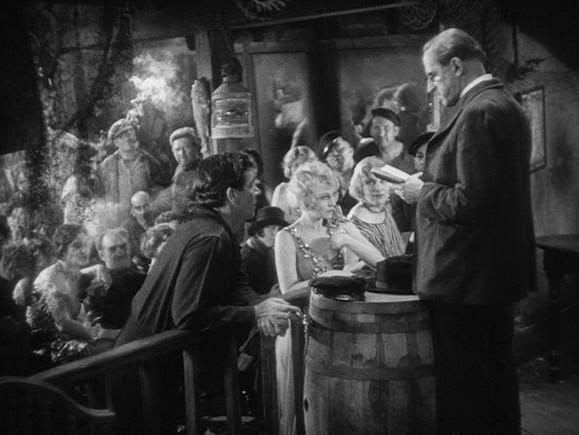
 Josef von Sternberg’s 1928 silent movie depicting the life of the destitute on the New York waterfront, is one of the great American films.
Josef von Sternberg’s 1928 silent movie depicting the life of the destitute on the New York waterfront, is one of the great American films.
I’m a devotee of silent films, which I love and collect, yet even I have to admit that, in many cases, one must make certain allowances in terms of the styles and conventions of the times in order to enjoy them. But that’s not at all the case for The Docks of New York, from 1928, directed by Josef von Sternberg. This film achieves a mastery of cinematic form that is rare for any era—silent or sound. Indeed, to watch it is to recognize the unique potential for artistic expression represented by the silent film at its peak.
A steamship stoker named Bill, played by George Bancroft, on a day’s leave on the New York waterfront, rescues a dance hall girl—a euphemism for prostitute in those days—who has tried to drown herself. Her name is Mae, and she’s played by Betty Compson. Bill takes her to the local saloon/brothel where, as it turns out, they know her. One of the women (played by Olga Baclonova) who helps revive her, is married to the ship’s captain, a surly oaf who has his eye on the prostitute. The stoker, resentful of the captain, falls for Mae, and then decides to go through a wedding ceremony with her that night in the saloon, all the while planning to leave her the next morning, because he can’t see himself giving up the sailor’s life. The wedding sequence is one of the film’s most amazing set pieces, as a local minister is dragged in to perform the ceremony in the midst of drunken carousing. The noise settles down momentarily as Bill and Mae make their vows, then the raucous celebration renews with added intensity. Here, as throughout the picture, we vividly experience the loneliness and isolation of the two main characters, in the midst of a dark world that can’t see anything beyond the pleasure of the moment.
From this rather meager story, Von Sternberg creates the feeling of a grimy little world, with an atmosphere of squalor and brutality, lit up by flashes of tenderness. Impeccably shot by Harold Rosson, with the director’s style of “shadows and light” much in evidence, the picture sports a fluid moving camera and a pace that is consistently absorbing. The Jules Furthman screenplay (based on a John Monk Saunders story) is almost devoid of sentimentality. The acting is restrained. Bancroft conveys a kind of impassive strength and self-regard—assuming that nothing can get in his way rather than having to prove it. The lovely Compson underplays the sadness of her role, thereby making her character more memorable. Some credit for the quality of the performances must of course go to the director, Von Sternberg, who had already distinguished himself in Hollywood by inspiring natural performances from his actors.
There is a complete absence of the kind of pompous moralizing that would have been required in films a decade later when depicting such lower class types. This is the life these people lead, the film says—see it for what it is, the good and the bad—it’s not the movie’s job to tell you what to feel. It doesn’t need to. It just shows you what it’s like for these characters on “the bottom” of the social heap, which includes moments of joy, contentment and humor, as well as, at times, being frightened or simply appalled.
And the miracle in all this is that The Docks of New York, even within the cramped, smoky confines of its world, leaves us with a memory of real beauty. It didn’t do well at the box office at the time, and it could use some more appreciation even today, because there’s no doubt, at least in my mind, that it’s one of the masterpieces of American film.






